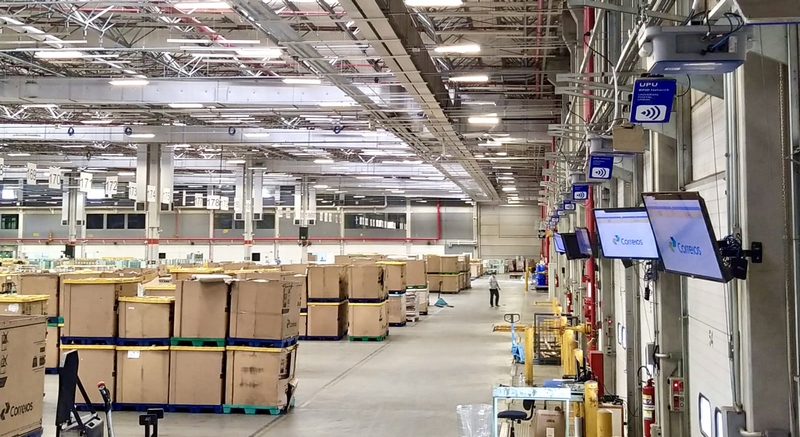Edson Perin
Correios, the Brazilian postal operator, has been working closely with União Postal Universal (UPU), post agency of the United Nations (UN), and GS1 Brasil, non-profit organization dedicated to implementing global standards for visibility into supply chains, to improve tracking of postal cargo through its sorting centers using radio frequency identification (RFID) technology.
Correios implanted RFID tags in cargo containers, which hold hundreds of packages, and installed around 2,000 readers at the entrances and exits of operational units, to better track letters and parcels in its network. This was done in partnership with the UPU through its Global Monitoring System program and the GS1. RFID tags include the standard GS1 Serial Shipping Container Code (SSCC) as a postal item identifier.
According to Correios, this is the world’s first postal cargo tracking project using ultra-high frequency (UHF) RFID technology. Correios also decided to maintain its established tracking process, which uses bar codes, along with the new RFID system, as there are still some challenges regarding the deployment of electronic tags.
UPU assisted Correios in selecting RFID tracking technology to ensure purchases were made in the most efficient and cost-effective manner. Therefore, passive rather than active RFID tags were chosen to keep costs low. In addition, thanks to the UPU’s partnership with GS1, Correios started to use labels with the most used standard (GS1 SSCC) for rapid adoption of the technology, even outside the postal sector.

Through RFID technology, Correios can now more accurately track and manage freight containers and their contents as they enter and exit distribution centers – without the need to manually scan barcodes. In addition, some mail items that pass through Correios hubs also have their own RFID tags for better tracking.
These tags can use the GS1’s Scan4Transport (S4T) (learn more at Scan4Transport codifica dados de transporte em etiqueta de logística select English version), which is a new global standard for encoding transport data on a postal label. According to GS1, the S4T standard can capture the key data needed to help deliver the first mile, classification and last mile. It is not yet in use by the Post Office.
Correios customers can also purchase RFID tags for their own orders. One customer that is testing this is the Brazilian footwear manufacturer Via Marte (learn more at Via Marte usa padrão GS1 em e-commerce pioneiro via Correios select English version), which inserted RFID tags using GS1 global standards into its products for faster identification through the Correios mail flow and to minimize delivery errors.
Antonio Caeiro, UPU’s quality measurement program manager, says the GS1 standards are used internally, as required by Correios do Brasil, with the aim of ensuring interoperability with domestic customers who send RFID-tagged household items via Correios. “The UPU standards are also in use to ensure interoperability between UPU member countries that exchange RFID-tagged items internationally.”
To date, Correios has purchased 27 million RFID tags encoded with GS1 SSCC keys. These labels are also printed with the GS1-128 barcode, which enables a matching process with the UPU S10 code at the 237 Post Office branches. In the next tender, Correios will acquire the so-called “integrated label”, where the labels will have an SSCC coding and will have an S10 printed on them, which will eliminate the SSCC + S10 correspondence process established today.
The success of the Correios RFID project is due in part to the strong partnership that UPU and GS1 have developed over the last decade. In 2010, the two organizations signed a memorandum of understanding to develop an RFID-based automatic product identification system for the postal network. Over the years, GS1 has worked closely with the UPU GMS team to see how their standards could help with postal tracking.
Then, in mid-2019, GS1 became an official member of the UPU Advisory Committee, which represents the interests of the wider postal sector and provides a framework for effective dialogue between Posts and the UPU and stakeholders, including NGOs. , standardization and financial organizations, providers of goods and services to the postal sector, transport entities and other entities that have an interest in supporting the mission and objectives of the UPU.
According to Walter Trezek, Chairman of the UPU Advisory Committee, the successful collaboration between GS1 and Correios, resulting in highly competitive and efficient e-commerce solutions, is a perfect example of how broader players in the postal sector, such as GS1, and designated operators such as Correios, create value and increase the competitiveness of the postal sector.
On July 1, 2022, the Advisory Committee launched a new membership structure as part of the International Secretariat’s goal to open the union to more private sector participants and, in turn, help designated operators accelerate transformation through scanning.



















